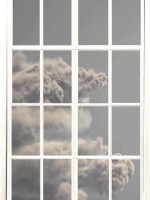There’s good reason why The New York Times called art sites that “quirky little gallery.” Thanks to its inventive director, Glynis Berry, this landmark art space in the sleepy, historic town of Riverhead, Long Island in New York, has persevered during this recession where others have failed. Ms. Berry loves to mix and match works by well known artists together with art by emerging artists, many with untraditional art backgrounds. She looks first for great art, and then gauges how it reflects a certain theme. “Nature Incorporated,” the current exhibition featuring works by eight artists, demonstrates the success of her method.
An installation by acclaimed conceptual artist, Hope Sandrow, in collaboration with photographer Ulf Skosbergh, provides the focal point for this exhibition. It’s based on Sandrow’s “Open Air Studio,” a living environment she created after a chance encounter with a chicken that followed her home from a morning walk. Discovering that the magnificent cockerel was one of an endangered species, she found him some mates and provided a safe habitat for the ensuing brood that now serves as a working studio for her provocative, poignant art.
The installation consists of (Re) Collection, Open Air Studio, spacetime, six bell jars containing chicken feathers, sorted by color, and two enormous photographic enlargements of single silken plumes. One image, Paduan Breed Fowl; Tolbunt, spans sixteen feet. The jars with feathers suggest both the suffocation of a species, and the need to protect what is delicate and fragile. Emboldening that message are massive photographs that detail an incredible, almost magical microcosm: hidden abstractions reminiscent of landscapes, thick with spiny grasses.
Hidden surprises in nature also inform Robert Oxnam’s weathered wood sculpture. An Asia scholar, he came to his art later in life, also while taking a walk. Oxnam intuits in the decaying wood roots he discovers along the shore of his Long Island home the same metaphysical qualities that ancient Chinese scholars attributed to the rocks they collected; natural stones resonating the mysteries of Mother Earth. Following in this scholar’s tradition, Oxnam cleans his weathered finds, locates their balance points, then applies layers of organic milk paint, burnished with wax, to reveal their yin/yang qualities. The twisting limbs of Anthracite, for example, contort like a practiced yoga master as he settles into calm repose.
Similar philosophies move Andrea Cote, who makes rubber molds of her body parts and uses them to print one-of-a-kind lithographs. Her series of Body Print Mandalas recall oriental abstract designs, and like those intricate abstractions, her graceful and delicate compositions convey ethereal visual poetry.
Tracy Heneberger is well known for sculpture made from oddball natural media: squid, sardines, anchovies, antlers, shark parts, and vegetables, coated with resin and epoxy, or cast in metal. Alter Ego: a golden choker accessory to décolleté? No, a shark’s jaw, its jagged teeth still packing a deadly bite. Like “Bouffant,” a tempting cluster of epoxy-coated pomegranates, it says, “don’t touch.” Heneberger’s works deliberately and simultaneously compel and repel, reminding us that nature, both giving but precarious, can’t be allowed to perish by our careless greed.
Environmental issues also course through Scott McIntire’s paintings. His figurative natural forms coexist with “energy fields,” abstractions of hi-tech currents piercing the atmosphere, unseen. In “Sumac Energy Field,” a landscape of berried plants becomes one with a glowering red space firing circles of searing energy. Flanking this central composition, two waiflike trees stand at the mercy of a yellow sky, snapping sparks from distant high wires.
Nina Yankowitz, who i an acclaimed installation artist, brings Armageddon cinema to this show with Global Warming Window. This video projection provides a virtual window through which one views an innocuous rainfall turning nasty, then catastrophic. The storm moves on. But it leaves behind a deluge cascading through the lower-level window of a lovely home, a timely reminder of a planet in peril.
Firebrand activist Lillian Ball takes global warming matters into her own hands. A celebrated conceptual sculptor turned eco-artist, she has garnered new acclaim for her WATERWASH projects, reclaiming flora and sea-life from polluted waters. The permeable material she uses to filter out pollutants in her projects on Long Island and in the Bronx make striking sculpture. WATERWASH Outtakes is a sparkling fantasy-like work made of salvaged castings from the Bronx WATERWASH site.
Hideaki Ariizumi, Ms. Berry’s husband, is an architect and co-director of art sites. His watercolor sketches proffer happy endings to eco-woes. By turns diagrammatic and abstract, these drawings point the way to more sustainable and beautiful habitats. “Intertwining,” for example, a semi-abstract layering of a house within a glasshouse, blurs the lines between interior and exterior space, suggesting living space drenched in natural light, with greenery providing natural beauty and privacy.
This show, energetically paced in its eclectic variety, juggles it all: installation art, sculpture, painting, works on paper, philosophy, history, ecology, and politics, all held together by that magical glue we call great art.
(Joyce Beckenstein is a writer and art critic who divides her time between Long Island’s North Fork and Manhattan.)
